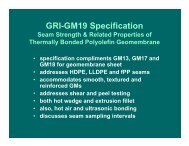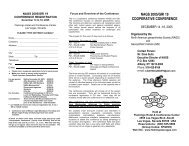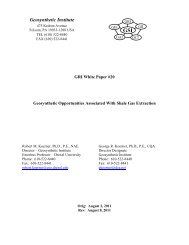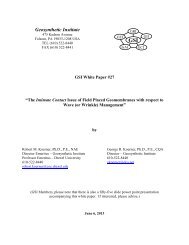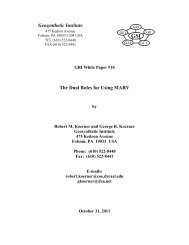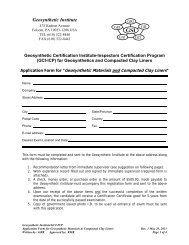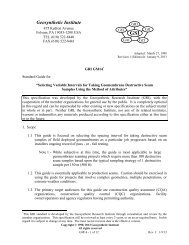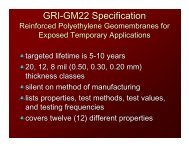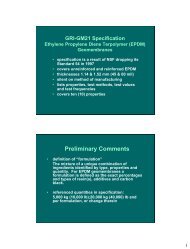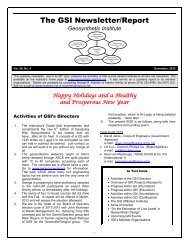GCL Design Guide - The Geosynthetic Institute
GCL Design Guide - The Geosynthetic Institute
GCL Design Guide - The Geosynthetic Institute
Create successful ePaper yourself
Turn your PDF publications into a flip-book with our unique Google optimized e-Paper software.
Note 7: <strong>The</strong>re are several other possible interpretations of selecting<br />
design shear strength based on peak, residual, or even largedisplacement<br />
conditions.<br />
8.2.5 Creep—It is well known that polymeric materials in tension can fail in<br />
sustained load creep at lower stresses than their short-term tensile strength.<br />
Creep and aging of polymeric materials placed in tension are handled in<br />
reinforced soil applications by applying reduction factors to the peak<br />
strength of the materials; see GRI White Paper #4 (2005). In the absence<br />
of long-term direct shear tests to determine the creep limit of the <strong>GCL</strong><br />
reinforcement fibers or yarns (that is, the stress level above which the<br />
reinforcement will creep to failure within the design life of the project), a<br />
creep reduction factor of three has been recommended by Marr and<br />
Christopher (2004) based on creep reduction factors normally used for<br />
polypropylene (PP) fibers in tension. This value might be somewhat<br />
conservative due to anticipated composite bentonite-to-fiber reinforcement<br />
interaction that is not present in conventional creep tests used to obtain the<br />
stated reduction factor. Published papers by Koerner, et al. (2001),<br />
Siebken, et al. (1995), Trauger, et al. (1995) and Zanzinger and Saathoff<br />
(2010) have shown that the majority of internal shear displacement occurs<br />
during the first 100 h of loading. In this regard, the initial 10 to 30 days<br />
after installation is critical. At the <strong>GCL</strong> landfill cover slope tests in<br />
Cincinnati (Scranton, 1996) reinforced <strong>GCL</strong>s have remained stable with<br />
little or no ongoing deformation on slopes as steep as 2H:1V since 1994.<br />
This implies a minimum slope stability factor of 1.5 when applied to<br />
3H:1V slopes. Of course, these are at low normal stresses. Unfortunately,<br />
there are no similar studies conducted at high normal stresses. <strong>The</strong> latest<br />
study by Müller (2008) states that a <strong>GCL</strong> with defined resin properties and<br />
an antioxidant package of the fibers of a double sided needle-punched<br />
nonwoven <strong>GCL</strong> has a lower limit of functional durability of at least 250<br />
years at 15°C.<br />
8.3 Interface Shear Strengths—In addition to internal shear strength of <strong>GCL</strong>’s, the<br />
designer must consider the interfaces between its outer surfaces and the adjacent<br />
materials (as well as all other interfaces of other adjacent liner components and<br />
their respective shear strengths). In all cases, it is recommended to test productspecific<br />
materials to be used in the design and the applying site-specific<br />
conditions. <strong>The</strong> basic test procedure is according to ASTM D 6243. It is<br />
important to recognize that this test method is silent on selection of important test<br />
variables such as type of liquid, saturation, consolidation time and load,<br />
displacement rate, amount of displacement, etc. <strong>The</strong>se are important decisions<br />
which will significantly influence the test results.<br />
8.3.1 Shear Strength of Nonreinforced Bentonite <strong>GCL</strong>s—For those <strong>GCL</strong>s which<br />
have bentonite bonded to a geomembrane, a critical interface will be<br />
<strong>GCL</strong>5 - 14 of 34 Rev. 1: 1/9/13



